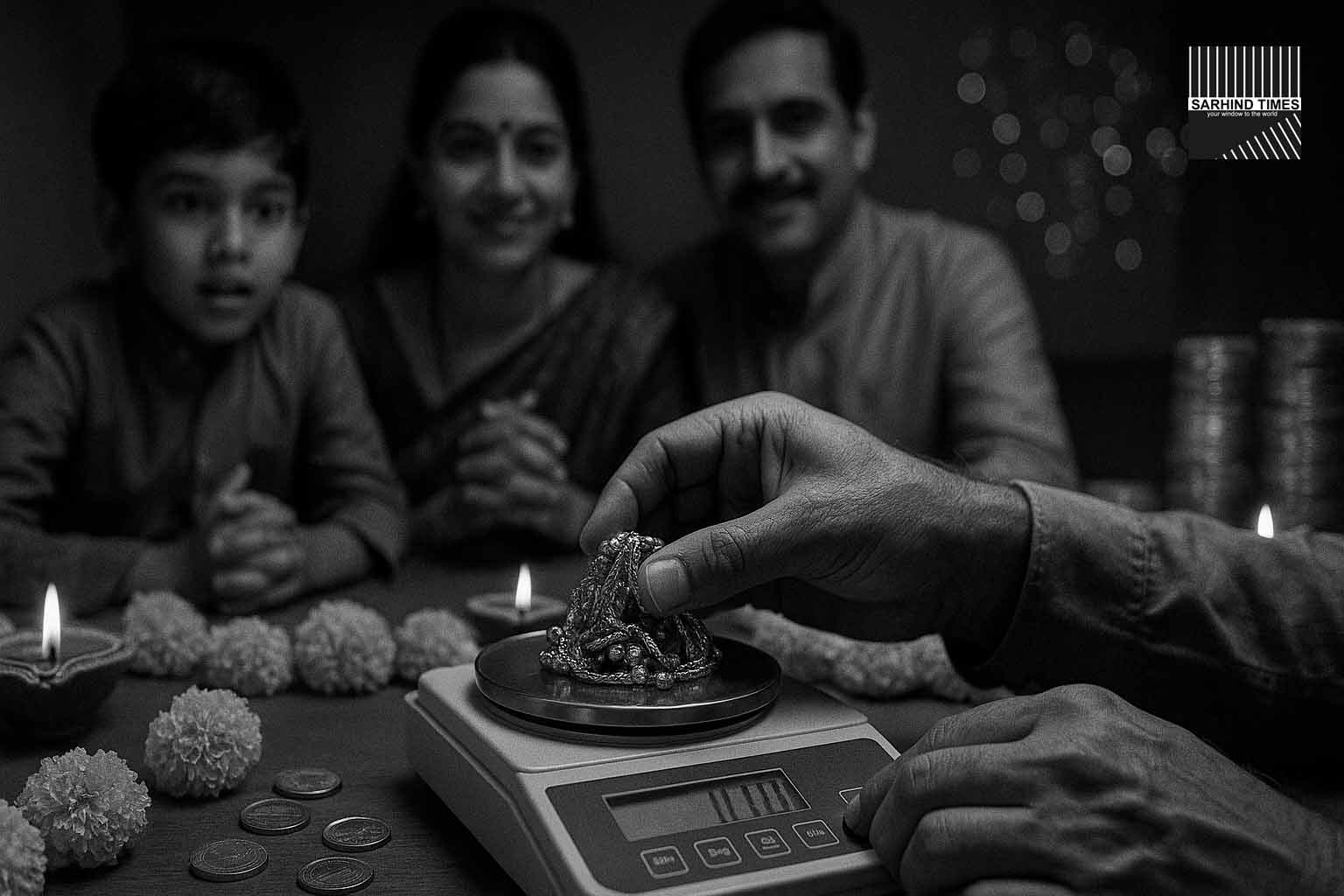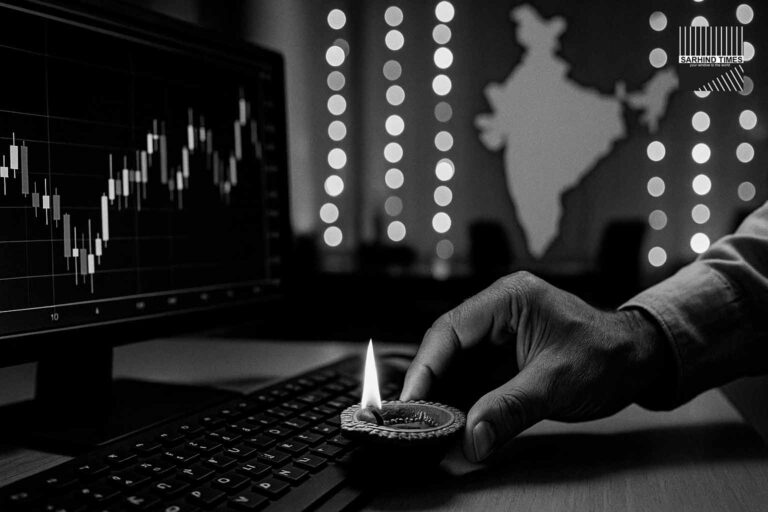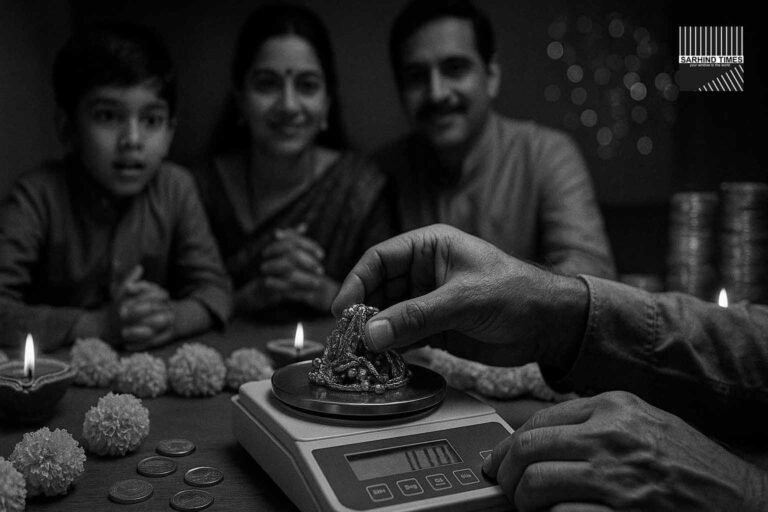By SarhindTimes Business Desk | Mumbai | Tuesday, October 21, 2025
Lead
In the year that tested global markets, gold and silver emerged as India’s most glittering investments—soaring nearly 60% since last Diwali, outpacing stocks, bonds, and cryptocurrencies. What began as a cautious hedge against global uncertainty became a runaway rally powered by central-bank buying, currency jitters, and investor faith. As Indians light diyas this Diwali, they are also lighting up balance sheets—with gold once again proving why it is more than just metal: it is memory, insurance, and identity.
The Rise and Shine Story
At the start of Samvat 2081, few analysts predicted that bullion would deliver the kind of returns it ultimately did. The Sensex managed a respectable 6 percent gain; the Nifty 50 inched forward amid earnings volatility. But gold—once dismissed as a “sentimental” asset—outperformed everything with a vengeance.
Spot prices crossed ₹80,000 per 10 grams for 24-carat gold by early October 2025, while silver pierced ₹100,000 per kg for the first time in Indian trading history.
A year earlier, both hovered near ₹50,000 and ₹63,000 respectively.
That’s an appreciation of roughly 60% in one Samvat year—an extraordinary move even by precious-metal standards. Analysts at India Bullion and Jewellers Association (IBJA) say this rally puts gold’s 2025 performance among the top five in the last half-century.
The Global Currents Behind the Surge
1. Geopolitical Fear Premium
Conflict hotspots across the Middle East and Eastern Europe kept safe-haven demand alive. Investors sought physical stores of value amid volatility in oil and shipping routes.
As one bullion analyst put it: “Every headline that shakes confidence in fiat currencies pushes another rupee into gold.”
2. Central-Bank Accumulation
According to World Gold Council data, central banks—led by China, Turkey, and India—added a record 1,200 tonnes to their reserves this year.
This institutional demand created a floor under prices, making corrections shallow and short-lived.
3. Currency Depreciation
The US Dollar Index fluctuated wildly as rate cuts began in advanced economies. When real yields compressed, gold’s relative attractiveness rose. The rupee’s gentle slide further amplified domestic returns for Indian buyers.
4. Supply Constraints
Major refineries faced logistics bottlenecks, while silver production dipped due to mining slowdowns in Latin America. Lower supply met relentless demand, creating textbook scarcity.
The Indian Connection: Culture Meets Capital
Few countries intertwine emotion and investment like India does with gold. Festivals such as Dhanteras and Akshaya Tritiya remain traditional buying windows, with demand surging every October-November.
Despite record prices, jewellers across Zaveri Bazaar, T. Nagar, and Karol Bagh reported steady footfall this Diwali week.
However, patterns have changed:
- Buyers are opting for lighter, design-driven jewellery instead of heavy sets.
- Gold coins and digital gold saw unprecedented traction.
- Younger investors prefer sovereign gold bonds (SGBs) and ETFs for safety and tax efficiency.
Ramesh Kumar Soni, president of the All India Bullion Traders Association, observed:
“Consumers are price-sensitive but emotionally consistent. Even at ₹80,000, gold is not expensive—it’s insurance that never expires.”
Silver’s Stunning Comeback
Silver often plays second fiddle to gold, but in 2025 it stole the spotlight. Used heavily in EV batteries, solar panels, and electronics, silver benefited from both industrial demand and precious-metal sentiment.
Experts note that the green-energy transition is quietly transforming silver from a decorative metal to a strategic commodity.
“Silver has effectively become green gold,” says Dr. Megha Nayak, an energy-metals researcher at IIT Bombay.
With government incentives for solar manufacturing and electric mobility, domestic consumption is set to climb another 15–20 percent in FY 2025-26.
The Investment Angle: Beyond Glitter
For portfolios, the message is balance.
Financial planners suggest keeping 5–10 percent of net worth in gold (via SGBs or ETFs) as a hedge.
The metal’s negative correlation with equities makes it valuable in turbulent times.
Rajesh Mehta, a wealth advisor at HDFC Securities, notes:
“Equities build wealth, gold preserves it. In 2025, preservation outperformed ambition.”
He cautions, however, that chasing parabolic rallies can be dangerous:
“Buy in tranches, use SIP-style allocations, and avoid leveraged futures positions. The goal is protection, not speculation.”
The Return of Sovereign Gold Bonds (SGBs)
The government’s SGB scheme has quietly matured into one of the smartest retail instruments available.
Investors earn 2.5 percent annual interest, enjoy capital-gains exemption on redemption, and avoid storage risks.
With RBI issuing tranches almost every quarter, SGB holdings crossed ₹65,000 crore this year.
The latest tranche, open during Navratri, saw oversubscription in two days. Many investors redeemed older tranches—locking in 40–50 percent capital gains.
This shift from physical to digital gold is reshaping India’s bullion landscape: fewer idle ornaments, more transparent holdings, and an easier interface with banking systems.
Global Parallels: A Tale of Two Assets
Interestingly, as gold soared, Bitcoin stabilized around the $60,000 mark—showing that the “digital gold” narrative did not cannibalize the original.
Institutional investors now treat the two as complementary: one backed by faith and history, the other by code and scarcity.
Morgan Stanley’s commodities desk recently commented that “gold’s physical scarcity remains its ultimate algorithm.”
Impact on Jewellery and Exports
India exported nearly $20 billion worth of gems and jewellery in FY 2024-25.
But rising raw-metal prices squeezed margins. Many export-oriented manufacturers hedged aggressively on the MCX and London Bullion Market.
Domestic retail, however, held steady. Chains like Tanishq, Malabar, and Kalyan introduced “swap schemes” letting customers exchange old gold for new designs at minimal loss.
The result: recycled gold now contributes about 15 percent of total retail supply—a sustainability milestone rarely highlighted.
What Lies Ahead for 2026
Analysts are divided.
If inflation cools further and central banks ease rates, the dollar could weaken, extending bullion’s momentum.
But if risk appetite revives in equities, funds might rotate out of gold into growth assets.
Technically, charts show support near ₹76,500 and resistance around ₹83,000.
Silver, more volatile by nature, could see ₹1.05 lakh/kg if industrial demand stays robust.
The key variables will be:
- US Fed’s rate trajectory
- India’s rupee stability
- China’s consumption rebound
- Global conflict resolution or escalation
Cultural Resilience: Gold as Emotion
Ask a bride in Jaipur or a grandmother in Coimbatore, and you’ll hear the same sentiment: “Gold is our family’s backbone.”
Economies may digitize, but the tactile comfort of holding metal persists.
As sociologist Dr. Ananya Varma explains:
“Gold acts as intergenerational glue. It transfers not only value but memory—from mother to daughter, from crisis to comfort.”
This emotional liquidity ensures that even when millennials buy ETFs, they do so with the same reverence that their grandparents brought to jewellery counters.
Policy Dimension: From Import Duties to Hallmarking
The government continues to balance between trade deficit management and consumer protection.
Import duties, currently at 15 percent, may be recalibrated if runaway imports pressure the current account.
Meanwhile, the mandatory hallmarking regime expanded to over 350 districts, ensuring purity transparency.
Digital hallmark verification via BIS Care App is catching on, bridging trust gaps in semi-urban markets.
Beyond the Diya: ESG and Ethical Gold
The next frontier is ethical sourcing.
Large jewellers are experimenting with recycled gold, blockchain-based traceability, and ESG reporting.
International buyers increasingly demand origin certification, pushing Indian refiners to upgrade compliance.
This evolution could turn India into not just the largest gold consumer but also a global ethical-gold hub.
Conclusion: The Metal That Mirrors Mood
Gold and silver, in their quiet luster, have chronicled India’s emotional and financial cycles for centuries.
They rise when fear rises, steady when hope flickers, and glitter most when uncertainty reigns.
In 2025, they were not just commodities—they were comfort.
As Samvat 2082 dawns, the candlelight on gold bangles and coins across India carries both sentiment and strategy: a prayer that prosperity stays as steady as the metal that embodies it.
#Gold #Silver #Diwali2025 #Investment #Bullion #SGB #IndianEconomy #Jewellery #SafeHaven #FinanceNews





















+ There are no comments
Add yours